
Work and energy are very common terms we use in daily communication, but they carry some deeper sense in the context of science. These concepts are related to the force, motion, and positions of objects that influence the activities around us.
When you play football, put the lights on, or see a running train, you can experience how work and energy join hands to make things happen.
This blog will make you understand which efforts lead to work and how energy conversions make our lives smoother and more convenient.
Also read: Acid, Bases, and Salt
What is Work?
In science concepts, work is said to be done when a force is applied to an object, and the object moves in the direction of the force. It is not just about doing physical activities; it’s a combined result of the force and displacement of the object.
It implies that if there is no displacement of the object, no work is done. For example, you may apply a lot of force to push a wall which doesn’t move. In this case, you have not done any work.
What is Energy?
Energy is the ability or capacity to do work. It exists in various forms, such as mechanical energy, heat energy, electrical energy, and more.
Energy is transferred or changes its form when work is done. For example, when you throw a ball, your energy is transferred to the ball and it gains kinetic energy.
Also read: Nutrition in Plants
Work and Energy Formula
In Physics, the work and energy formula are important in explaining practical activities and solving physics problems. Below are the work and energy formulas:
Work Done by a Constant Force
The formula is:
W=F⋅d⋅cos(θ)
Where:
-
W is the work done
-
F is the force applied
-
D is the displacement
-
θ is the angle between the force and the direction of displacement
Kinetic Energy
Kinetic Energy is the energy of a moving body. The formula that expresses it is as follows:
KE = ½ (mv²)
where:
-
KE is the kinetic energy
-
m is the mass of the object
-
v is the velocity of an object
Potential Energy
Potential energy is the stored energy of an object depending on its position. The formula that expresses it is as follows:
PE=m x g x h
where:
-
PE is the potential energy
-
m is the mass
-
g is the acceleration due to gravity (9.8 m/s²)
-
h is the height above the ground
Mechanical Energy (ME)
Mechanical energy is the sum of kinetic and potential energy. The formula that expresses it is as follows:
ME=KE + PE
Also read: Metals and Non- Metals
Positive, Negative, and Zero Work
Work can be positive, negative, or zero, depending on the direction of force and displacement. These are explained below:
-
Positive Work: When force and displacement are in the same direction. For example, lifting a bag upward.
-
Negative Work: When force and displacement are in opposite directions. For example, when a car moves, the frictional force of the road acts in the opposite direction.
-
Zero Work: When no displacement or displacement happens in the direction perpendicular to the force. For example, carrying a bag while walking on a flat surface.
It can be explained by the work formula W = F⋅d⋅cos(θ). In the above case, cos(θ) = cos (90) = 0. So, the work done is zero.
Also read: Living things and Non- living things
Work Energy Principle
One of the most important principles in physics is the Work-Energy Principle.
It states that the Net work done by all forces acting on an object is equal to the change in the kinetic energy of an object.
The following equation expresses it:
Net W = KE (final) - KE (initial) = ½ (mv²) - ½ (mu²)
Where:
-
u is the initial velocity
-
v is the final velocity
-
m is the mass
Units of Work and Energy
Both work and energy are measured in the same unit. The SI unit of work and Energy is Joule (J)
1 Joule = 1 Newton × 1 meter
It implies that 1 joule of work is done when a force of 1 Newton acts on a body to displace it by 1 meter.
Types of Energy
We can find energy in different forms as follows:
-
Mechanical Energy: Combination of kinetic and potential Energy.
-
Thermal Energy: Energy due to the motion of particles in a substance. It is commonly manifested as heat.
-
Chemical Energy: Energy stored in chemical compounds. For example, in batteries.
-
Electrical Energy: Energy obtained by the flow of electrons. For example, electricity in wires.
-
Light Energy: Energy carried by different wavelengths of light. For example, solar energy.
Also read: Leguminous plants: Definition, Types, and Examples
Conservation of Energy
The Law of Conservation of Energy states that energy can neither be created nor destroyed and can only be transformed from one form to another.
For example, when you throw a ball upward, following things happen:
-
It starts with kinetic energy
-
The kinetic energy transforms into potential energy as it moves upwards
-
When it reaches the highest point, the kinetic energy becomes nil, and the object contains only potential energy.
During the entire process, the total mechanical energy remains the same.
Applications of Work and Energy
The application of work and energy can be found in many activities and functions in real-life situations. Here are a few examples:
-
Sports: Kicking, hitting, or throwing a ball are examples of work you do.
-
Activities: You use energy while exercising, running, jumping, or swimming.
-
Machines: Machines and appliances run by electricity convert electrical energy into mechanical energy.
-
Engine: The car engine transforms chemical energy into mechanical energy.
-
Electricity: Power plants use mechanical energy to generate electrical energy.
-
Construction: Cranes do work by lifting heavy materials.
-
Cooking Oven: Cooking oven uses the conversion of chemical energy to heat energy.
Work and energy are very important scientific concepts closely associated with real life. A thorough idea of the work, energy, and related principles helps us understand how things move and operate.
Students who learn to define work and energy and interpret work and energy formulas, perform better academically and can relate these concepts to everyday activities.
Also read: Three States of Matter: Solid, Liquid, and Gas
Spark Your Child’s Curiosity and Love for Science with Curious Junior Online Classes
Does your child often lose focus during lessons, struggle with new concepts, or leave school assignments incomplete? CuriousJr brings the solution.
Our online science classes can make learning fun, relatable, and effective. We use interactive tools, real-life examples, and activity-based teaching methods to help your child understand and retain what they learn.
What Makes Our Program Unique?
-
Our engaging daily live sessions focus on teaching concepts through visual aids and practical examples to make the topics more interesting.
-
Every child receives personal guidance from experienced mentors who simplify tough topics and resolve doubts.
-
Our tutors assist with daily homework and school tasks during class and after through online support.
-
We inform parents with regular progress reports and feedback, helping them understand the child’s strengths and areas for improvement.
-
Our teachers adapt their methods based on each child’s learning style, pace, and unique needs.
Curious Junior online classes aim to make education practical, engaging, and child-friendly. Book a demo class today to help your child develop a genuine interest in science while gaining confidence and academic strength.
Do you need help with your homework or preparing for exams?
Study without using the internet
Work and Energy FAQs
Is work and energy a scalar quantity?
Give examples of inter-conversions between mechanical Energy and Electrical Energy.
Can displacement happen without any force?
How does potential energy get converted to other forms of energy?










